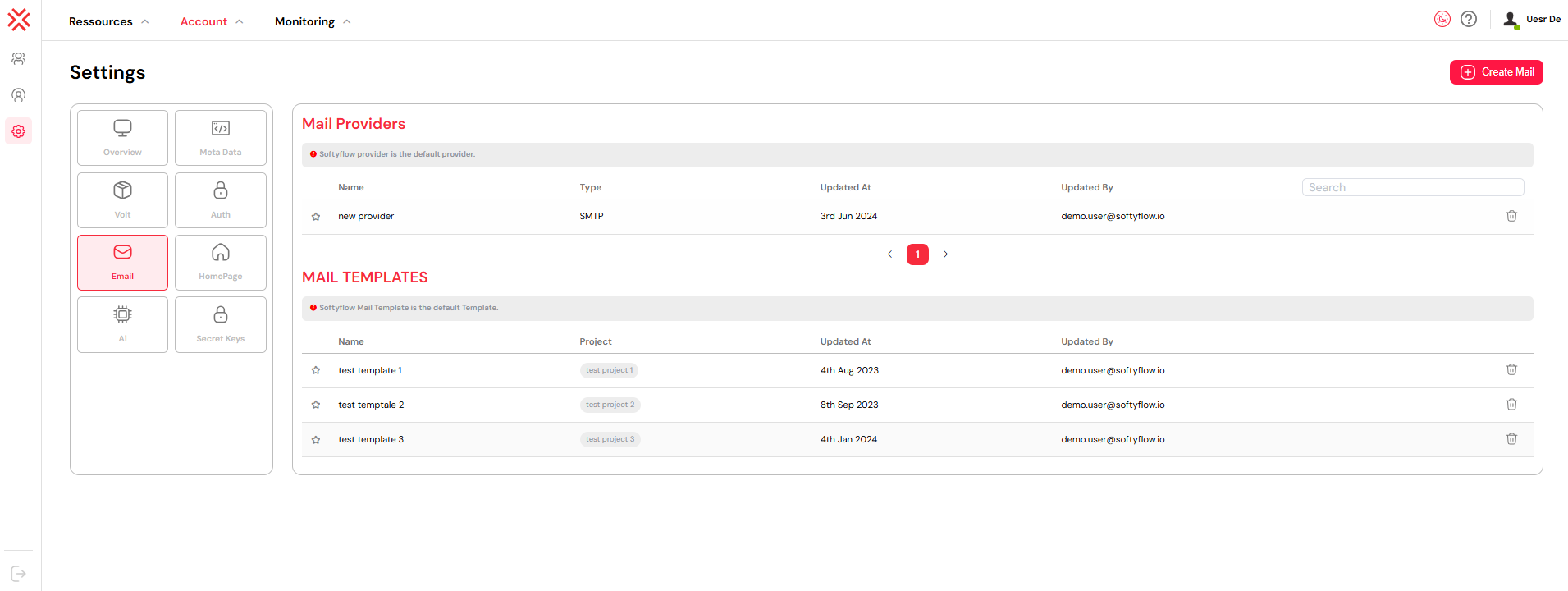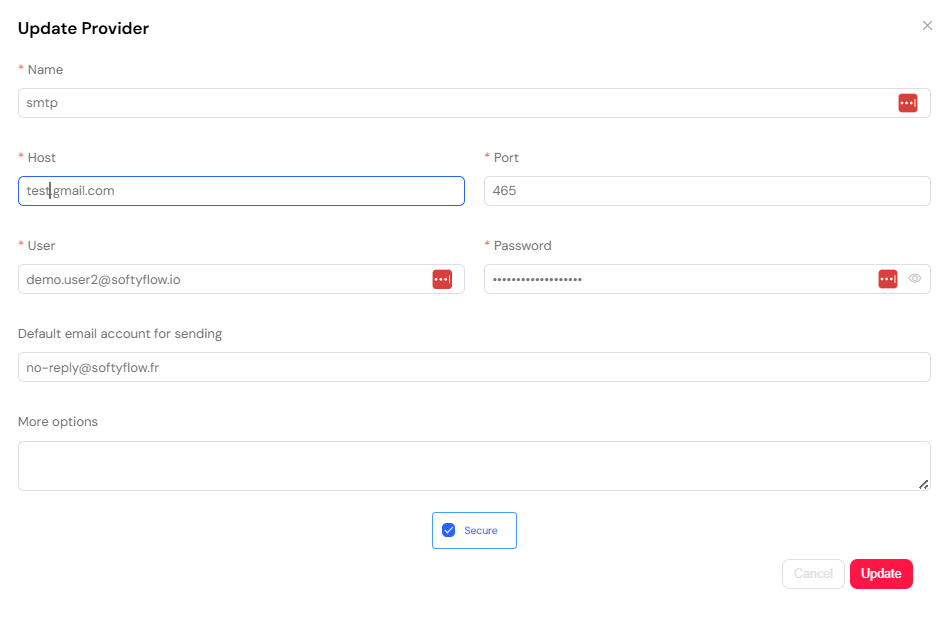Mail Management
Email notifications are a core feature of any workflow application they help streamline approvals, alert users to tasks, and ensure real-time communication. The Mail Management section allows you to configure and manage your email providers and templates in one place.
Mail providers integrate with user management for account notifications, authentication systems for password reset emails, process workflows for automated notifications, and web interfaces for form submissions.

1. Mail Providers
You can connect external SMTP providers to control how emails are sent from Softyflow. This gives you flexibility over sender domains, delivery tracking, and compliance with your organization's infrastructure.
To access it:
Go to Account → Settings → Email or navigate to /ide/mail-providers.
1.1. Create a Mail Provider
To add a new provider, click the Create Mail button then click on Mail Provider and fill out the following details:
Name: Internal name to identify this provider
Host: SMTP server hostname or IP address
Port: Port used by the SMTP service (e.g. 587 for TLS)
User: SMTP login email or username
Password: Corresponding password or application-specific password (consider storing sensitive credentials in Volt)
Secure: Enable if using TLS/SSL (recommended)

You can set a provider as default by clicking the "D" button next to its name in the list.
1.2. Use Cases
Once you've configured at least one mail provider, you can use it across your workflows and scripts to manage email communication effectively:
Send automatic workflow notifications: Whenever a task is assigned, escalated, or completed in process workflows, email alerts can be triggered to inform the right users in real time.
Trigger custom email alerts: Use the 'sendEmail' action in process scripts or integration workflows to send messages with dynamic content (e.g. approval summaries, error reports, confirmations).
Authentication notifications: Send password reset emails and account verification messages as part of your authentication system.
Form submissions: Send confirmation emails for web interface form submissions and user interactions.
Monitoring alerts: Configure email notifications for process errors using run monitoring capabilities.
Fallback to built-in provider: If no external provider is configured or set as default, Softyflow automatically uses its internal mail server to ensure continuity.
This ensures that your business processes stay responsive and that users never miss critical updates, even if an external mail service is unavailable.
1.3. Update a mail Provider
Click on any provider in the list to open its configuration. Make your changes and click Update to save, or Cancel to discard.

1.4. Delete a mail Provider
To remove a mail provider:
Open Settings → Email
Click the trash icon next to the provider you want to delete
Confirm the action when prompted
⚠️ You cannot delete the provider currently set as default switch to another one first.
2. Mail Templates
Email templates provide a standardized way to format and send emails across your platform. Templates can be used in process workflows, web interface notifications, and automated system alerts.
Creating Templates:
- Click Create Mail button then select Mail Template
- Define template properties:
- Name: Internal identifier for the template
- Subject: Email subject line (supports variables)
- Body: Email content with HTML formatting
- Variables: Dynamic placeholders for personalization
Template Features:
- Variable Substitution: Use
{{variable_name}}syntax for dynamic content - User Context: Access user data from user management (name, email, metadata)
- Process Data: Include process variables and workflow information
- Role-based Content: Customize content based on user roles
- HTML Support: Rich formatting with HTML tags and styling
Integration Points:
- Process Design: Use templates in process step notifications
- Web Interface Design: Send template-based confirmations for form submissions
- User Management: Send welcome emails and account notifications
- Authentication: Use templates for password reset and verification emails
- Run Monitoring: Automated error notifications with template formatting
Templates ensure consistent branding and messaging across all email communications while enabling dynamic content based on user metadata and process context.
3. Mail Integration
3.1. Development Integration
Mail providers integrate across the development lifecycle:
- Project Setup: Configure email settings for new projects
- Web Interface Design: Add email notifications to form submissions and user interactions
- Process Design: Build email notifications into workflow steps and approval processes
- Database Integration: Send notifications based on data changes and triggers
- Integration: Use email in external system workflows and API responses
- Reporting: Schedule and send report emails to stakeholders
- Test & Deploy: Configure different email settings for test and production environments
3.2. Administration Integration
Mail management works with other administrative features:
- User Management: Send welcome emails, password resets, and account notifications
- Role Management: Send role-based notifications and access confirmations
- Authentication: Password reset, 2FA setup, and security alert emails
- Settings: Use secret keys for secure SMTP authentication
- System Logs: Monitor email delivery and troubleshoot sending issues
- Run Monitoring: Automated error notifications and process completion alerts
3.3. Monitoring & Troubleshooting
Track email operations and maintain reliable communication:
- System Logs: Monitor email sending attempts, delivery status, and error messages
- Run & Instance Management: Configure email alerts for process failures and exceptions
- Provider Health: Monitor SMTP connection status and delivery rates
- Template Analytics: Track template usage and effectiveness
4. Next Steps
Continue building your communication infrastructure:
Email Configuration:
- Settings - Configure secret keys for secure SMTP authentication
- User Management - Set up user welcome emails and notifications
- Authentication - Configure password reset and security emails
- Run Monitoring - Set up process error notifications
- System Logs - Monitor email delivery and troubleshoot issues
Development Integration:
- Project Setup - Configure email settings for new applications
- Web Interface Design - Add email notifications to user interfaces
- Process Design - Build email workflows and automated notifications
- Database Integration - Set up data-driven email triggers
- Integration - Use email in external system communications
- Test & Deploy - Configure environment-specific email settings